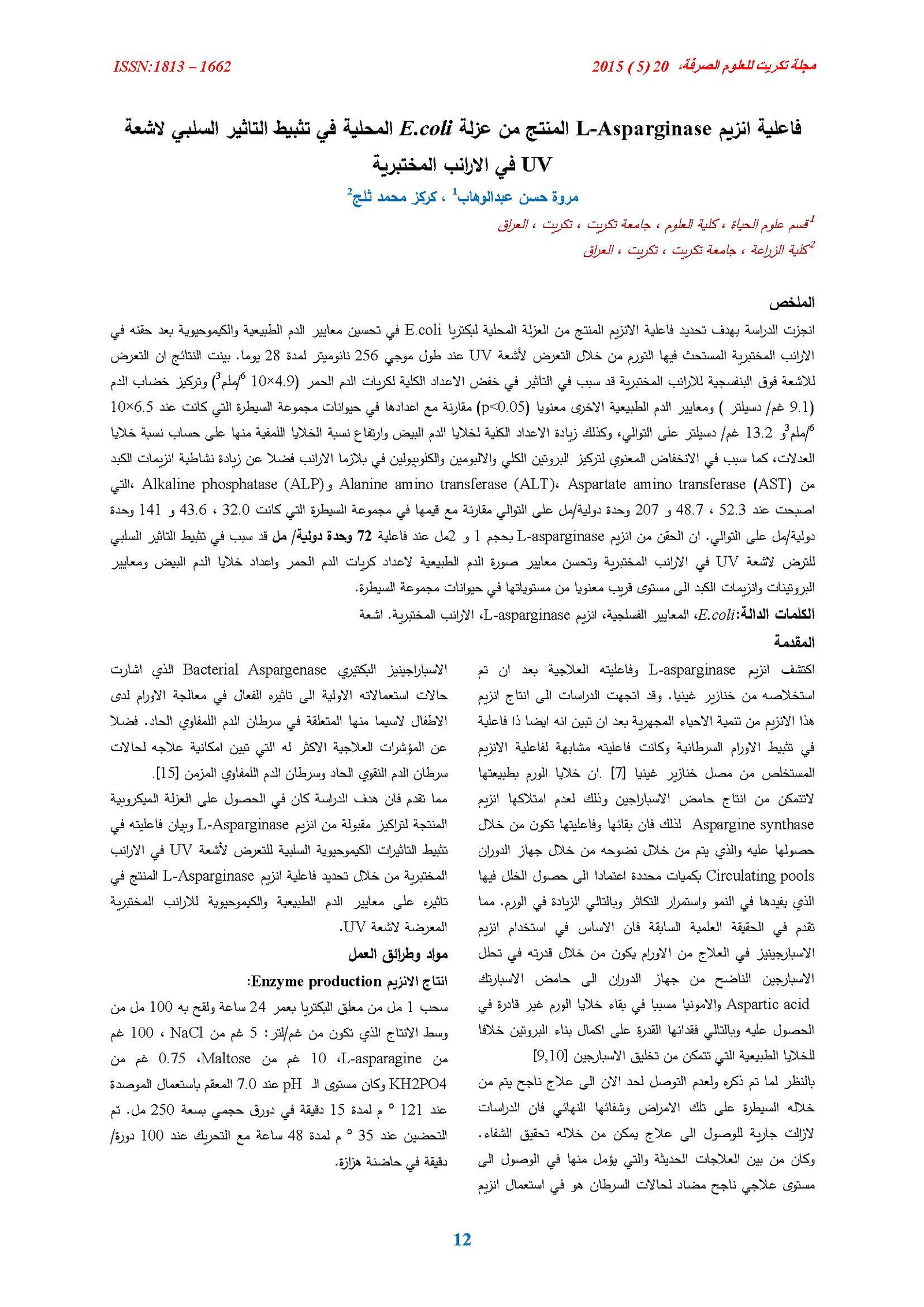Ability of L-Asparginase Produced from Locally E.coli Isolates on Negative Effect of UV Rays on Laboratory Rabbits
Main Article Content
Abstract
This study was carried out to illustrate the effective of injected L-asparginase enzyme produced from E.coli isolate at 1 and 2 ml on natural and biochemical blood characterized in laboratory rabbits induced tumor through exposure to UV rays with a wavelength 256 ƞm for 28 days. Results indicated that the exposure to UV arrays from laboratory rabbits have caused an significantly (p< 0.05) reducing the total count of red blood corpuscular RBCs which became at 3.0×106/mm3 and the hemoglobin concentration at 9.1 g/dl compared with the same value at animals control group which was at 6.5x106/mm3 and 13.2 g/dl, respectively, as well as increased the total count of white blood cells WBCs and lymphocytes percentage deposited neutrophils percentage. Also, was caused significantly decline of total protein, albumin and globulin concentration in rabbits plasma and increase its liver enzymes activates for Aspartate amino transferase (AST), Alanine amino transferase (ALT), Alkaline phosphatase (ALP), which became at 52.3, 48.7 and 207 IU/ml, respectively, compared with the control group values at 32.0, 43.6, 141 IU/ml, respectively. The injection of an L-asparginase enzyme at 1 and 2 ml contains (72 IU/ml) due to inhibition of negative influence of UV rays altered in laboratory rabbits and improved the natural blood picture as red blood corpuscular, white blood cells, proteins parameters and liver enzymes activities significantly to close levels in control group animals. It can be concluded that bacterial isolates from E.coli species were as efficient in the L-asparginase enzyme production and the effectiveness of this enzyme were high in improving physiological parameters of laboratory rabbits exposed to UV rays.
Article Details

This work is licensed under a Creative Commons Attribution 4.0 International License.
Tikrit Journal of Pure Science is licensed under the Creative Commons Attribution 4.0 International License, which allows users to copy, create extracts, abstracts, and new works from the article, alter and revise the article, and make commercial use of the article (including reuse and/or resale of the article by commercial entities), provided the user gives appropriate credit (with a link to the formal publication through the relevant DOI), provides a link to the license, indicates if changes were made, and the licensor is not represented as endorsing the use made of the work. The authors hold the copyright for their published work on the Tikrit J. Pure Sci. website, while Tikrit J. Pure Sci. is responsible for appreciate citation of their work, which is released under CC-BY-4.0, enabling the unrestricted use, distribution, and reproduction of an article in any medium, provided that the original work is properly cited.
References
1) Bregman, A.S. 1978. The formation of auditory streams.In J.Requin (Ed),Attention and Performance Vll.Hillsdale,New Jersey: Lawrence Erlbaum.
2) Dhevagi, P. and E. Poorani, 2006. Isolation and characterization of L-Asparaginase from marine actinomycetes. Ind. J. Biotech., 5: 514-520.
3) Duncan.D .B. 1955.Multiple range and multiple Ftest,Biometric,11,1-42.
4) Graham, M.L. 2003. Pegaspargase: A review of clinical studies. Adv. Drug Delivery Rev., 55: 1293-1302.
5) Guyton, Arthur C.; Hall, John E. 2006. Guyton and Hall Textbook of Medical Physiology with Student Consult Online Access (11th ed) Philadephia :Elsevier Saunders ISBN :216-240.
6) Hosamani, R., 2012. Studies on the production of L-asparaginase an antitumor agent from filamentous fungus-Fusarium equiseti. Ph.D. Thesis, Karnatak University, Dharwad, India.
7) Jain, R., K.U. Zaidi, Y. Verma and P. Saxena, 2012. L-Asparaginase: A promising enzyme for treatment of acute lymphoblastic leukiemia. People's J. Sci. Res., 5: 29-35.
8) Kind, P.R.N. and King, E.J. 1954. Estimation of plasma phosphate by determination of hydrolysed phenol with amino antipyrine. J. Clin. Pathol., 7: 322-326.
9) Kumar, K. and N. Verma, 2012. The various sources and application of L-asparaginase. Asian J. Biochem. Pharma. Res., 3: 197-205.
10) Pedreschi, F., K. Kaack and K. Granby, 2008. The effect of asparaginase on acrylamide formation in French fries. Food Chem., 109: 386-392.
11) Pourhossein, M. and H. Korbekandi, 2014. Cloning, expression, purification and characterisation of Erwinia carotovora L-asparaginase in Escherichia coli. Adv. Biomed. Res., Vol. 3. :10-41.
12) SAS, (2004). Gaide personal computer (ver.7) inst. Inc. Cary.Nc. USA.
13) Schottelius J, Gerken J,Centurion_Lara A. 1988. Comparative Studies on new world Leishmania and Trypanosoma by lectin tests and concanavalin A precipitation of /labelled cells.J.clin Chem Clin Biochem 26:834-835.
14) Serin, R.C. 2001. Intermediate measures of treatment success. Compendium 2000, pp. 198-201. Correctional Service of Canada, Ministry of Supply and Services.
15) Stecher, A.L., P.M. de Deus, I. Polikarpov and J. Abrahao-Neto, 1999. Stability of L-asparaginase: An enzyme used in leukemia treatment. Pharmaceutica Acta Helvetiae, 74: 1-9.
16) Thongsong,S.K;Thongsong.B.&Chavananikul,V. 2008. Blood haematological-cholesterol profile and antibody titer response of Broilers with added probiotic Containing both bacteria and yeast. J. Biochem, 12: 104-112.
17) Tietz, Y. 2005. Clinical Chemistry, 6 th ed. McGraw- Hill, New york. 825.
18) Verma, N., K. Kumar, G. Kaur and S. Anand, 2007. L-asparaginase: A promising chemotherapeutic agent. Crit. Rev. Biotechnol., 27: 45-62.
